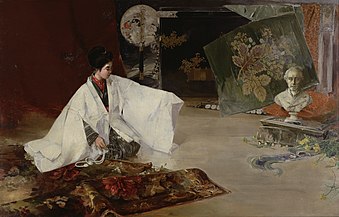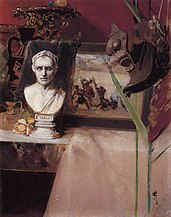Kawamura Kiyoo
Kawamura Kiyoo | |
|---|---|
 Kawamura Kiyoo in 1929 | |
| Born | 1852 |
| Died | 1934 |
| Nationality | Japanese |
| Known for | Painting |
| Movement | Yōga |
Kawamura Kiyoo (河村清雄) (1852–1934) was a yōga artist in Meiji to Shōwa Japan.
Life[edit]
Born in Edo in 1852, as a child he began to study under Sumiyoshi Naiki (住吉内記), before moving to Osaka prior to his grandfather's appointment as bugyō (magistrate). Continuing his education under Tanomura Chokunyū (田能村直入), after returning to Edo he studied for a time with Haruki Nanmei (春木南溟) before learning yōga from Kawakami Tōgai (川上冬崖), in around 1868.
Initially sponsored by Katsu Kaishū, with Tokugawa support he studied political law in America in 1871, travelling the following year to France and Italy. In Venice he turned to the study of painting. Returning to Japan in 1881, he worked for the Ministry of Finance Printing Bureau before resigning over a disagreement and opening a school for painting in Kōjimachi.
In 1889 he participated in the formation of the Meiji Bijutsukai (明治美術会), the first domestic art association to champion western-style painting. Within a decade the association had been eclipsed by Kuroda Seiki's Hakubakai (白馬会).
Kawamura Kiyoo often painted in western-style oil on traditional Japanese supports of silk and wood. He died in Tenri in 1934.[1][2][3]
Selected paintings[edit]
-
Summer Airing
-
Mount Fuji with Cherries
-
Interior Still-life
See also[edit]
References[edit]
- ^ 川村清雄 [Kawamura Kiyoo] (in Japanese). Mie Prefectural Art Museum. Retrieved 6 February 2016.
- ^ "2002". Nakagawa-machi Batō Hiroshige Museum of Art. Archived from the original on 11 March 2016. Retrieved 6 February 2016.
- ^ "The influence of French art in Japan". National Diet Library. Retrieved 6 February 2016.
External links[edit]
![]() Media related to Kawamura Kiyoo at Wikimedia Commons
Media related to Kawamura Kiyoo at Wikimedia Commons




